2016 TOYOTA AURIS TOURING SPORTS length
[x] Cancel search: lengthPage 113 of 660
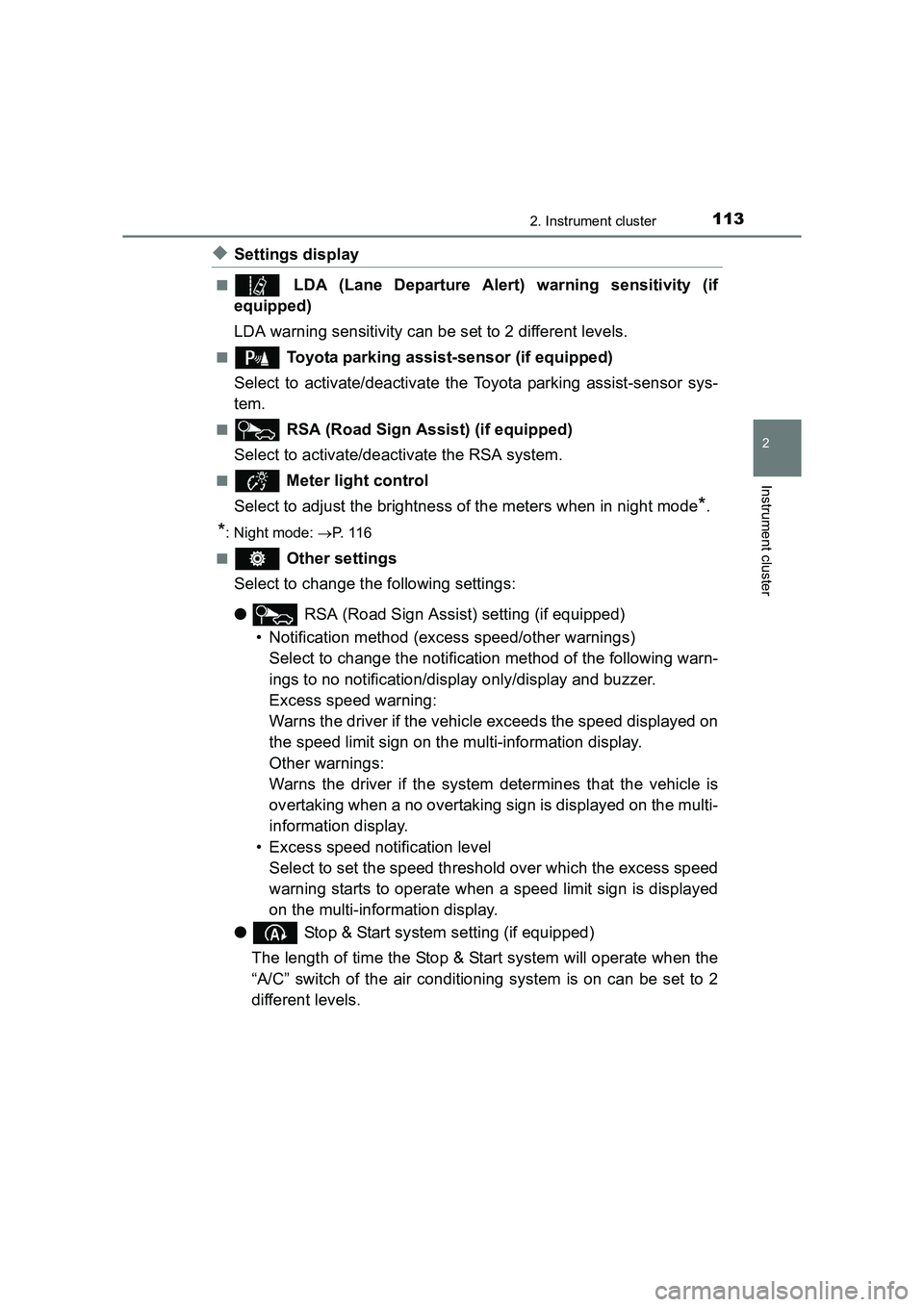
1132. Instrument cluster
AURIS Touring Sports_EE (12K53E)
2
Instrument cluster
◆Settings display
■ LDA (Lane Departure Alert) warning sensitivity (if
equipped)
LDA warning sensitivity can be set to 2 different levels.
■ Toyota parking assist-sensor (if equipped)
Select to activate/deactivate the Toyota parking assist-sensor sys-
tem.
■ RSA (Road Sign Assist) (if equipped)
Select to activate/deactivate the RSA system.
■ Meter light control
Select to adjust the brightness of the meters when in night mode
*.
*: Night mode: →P. 1 1 6
■
Other settings
Select to change the following settings:
● RSA (Road Sign Assist) setting (if equipped)
• Notification method (excess speed/other warnings) Select to change the notification method of the following warn-
ings to no notification/display only/display and buzzer.
Excess speed warning:
Warns the driver if the vehicle exceeds the speed displayed on
the speed limit sign on the multi-information display.
Other warnings:
Warns the driver if the system determines that the vehicle is
overtaking when a no overtaking sign is displayed on the multi-
information display.
• Excess speed notification level Select to set the speed threshold over which the excess speed
warning starts to operate when a speed limit sign is displayed
on the multi-information display.
● Stop & Start system setting (if equipped)
The length of time the Stop & Start system will operate when the
“A/C” switch of the air conditioning system is on can be set to 2
different levels.
Page 198 of 660
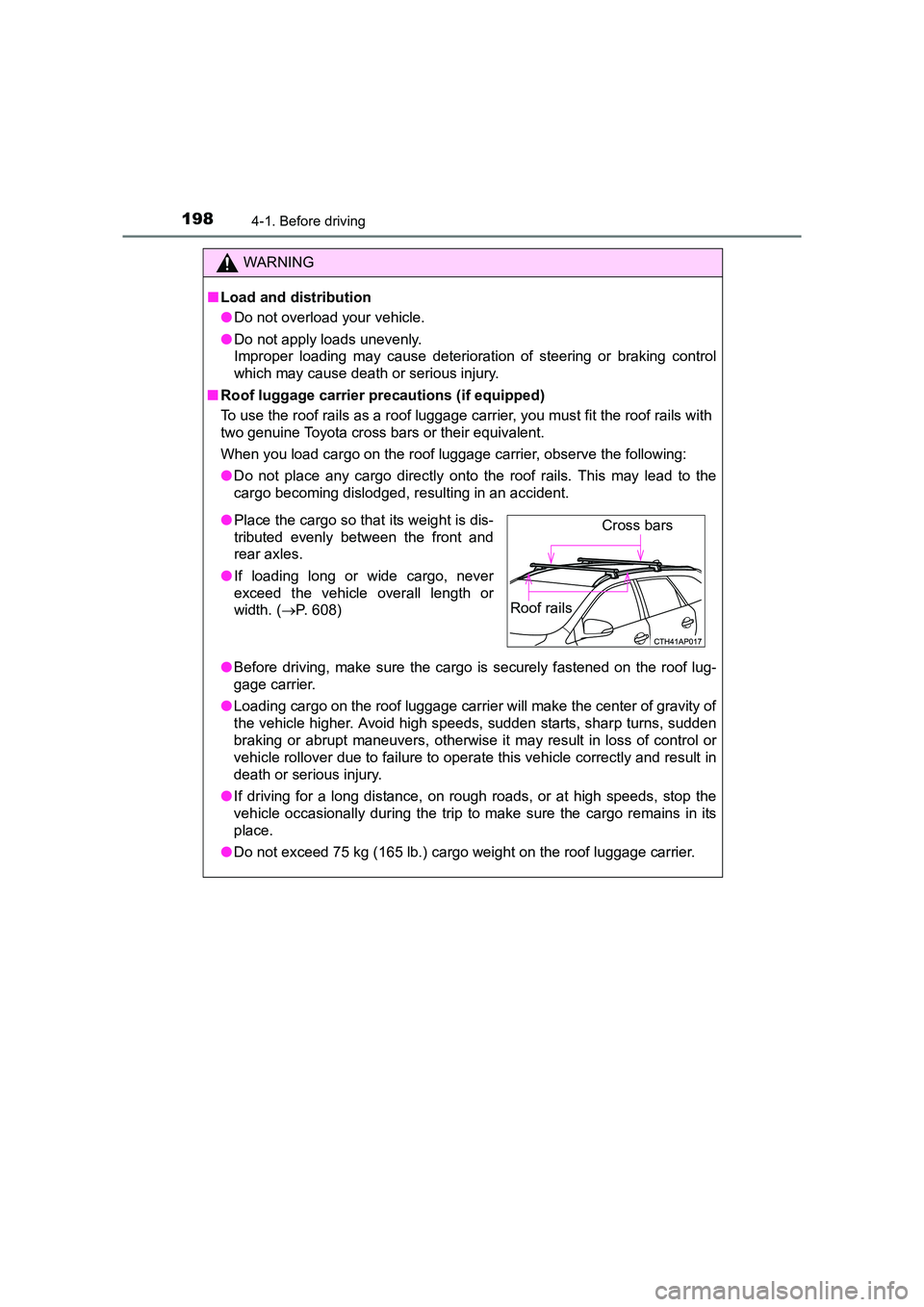
1984-1. Before driving
AURIS Touring Sports_EE (12K53E)
WARNING
■ Load and distribution
●Do not overload your vehicle.
● Do not apply loads unevenly.
Improper loading may cause deterioration of steering or braking control
which may cause death or serious injury.
■ Roof luggage carrier precautions (if equipped)
To use the roof rails as a roof luggage carrier, you must fit the roof rails with
two genuine Toyota cross bars or their equivalent.
When you load cargo on the roof luggage carrier, observe the following:
●Do not place any cargo directly onto the roof rails. This may lead to the
cargo becoming dislodged, resulting in an accident.
● Before driving, make sure the cargo is securely fastened on the roof lug-
gage carrier.
● Loading cargo on the roof luggage carrier will make the center of gravity of
the vehicle higher. Avoid high speeds, sudden starts, sharp turns, sudden
braking or abrupt maneuvers, otherwise it may result in loss of control or
vehicle rollover due to failure to operate this vehicle correctly and result in
death or serious injury.
● If driving for a long distance, on rough roads, or at high speeds, stop the
vehicle occasionally during the trip to make sure the cargo remains in its
place.
● Do not exceed 75 kg (165 lb.) cargo weight on the roof luggage carrier.
●Place the cargo so that its weight is dis-
tributed evenly between the front and
rear axles.
● If loading long or wide cargo, never
exceed the vehicle overall length or
width. ( →P. 608)Cross bars
Roof rails
Page 206 of 660
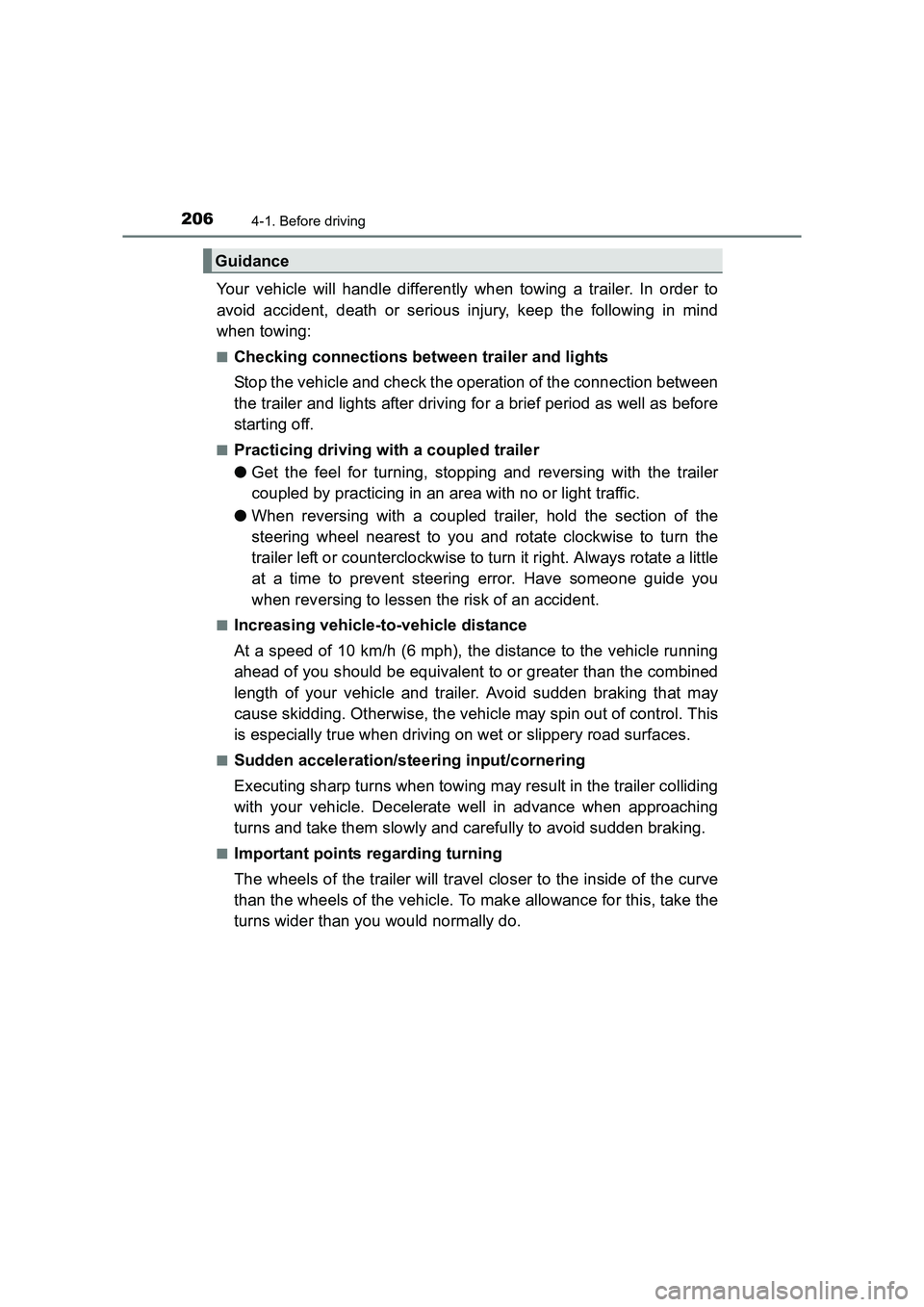
2064-1. Before driving
AURIS Touring Sports_EE (12K53E)
Your vehicle will handle differently when towing a trailer. In order to
avoid accident, death or serious injury, keep the following in mind
when towing:
■Checking connections between trailer and lights
Stop the vehicle and check the operation of the connection between
the trailer and lights after driving for a brief period as well as before
starting off.
■Practicing driving with a coupled trailer
●Get the feel for turning, stopping and reversing with the trailer
coupled by practicing in an area with no or light traffic.
● When reversing with a coupled trailer, hold the section of the
steering wheel nearest to you and rotate clockwise to turn the
trailer left or counterclockwise to turn it right. Always rotate a little
at a time to prevent steering error. Have someone guide you
when reversing to lessen the risk of an accident.
■Increasing vehicle-to-vehicle distance
At a speed of 10 km/h (6 mph), the distance to the vehicle running
ahead of you should be equivalent to or greater than the combined
length of your vehicle and trailer. Avoid sudden braking that may
cause skidding. Otherwise, the vehicle may spin out of control. This
is especially true when driving on wet or slippery road surfaces.
■Sudden acceleration/steering input/cornering
Executing sharp turns when towing may result in the trailer colliding
with your vehicle. Decelerate well in advance when approaching
turns and take them slowly and carefully to avoid sudden braking.
■Important points regarding turning
The wheels of the trailer will travel closer to the inside of the curve
than the wheels of the vehicle. To make allowance for this, take the
turns wider than you would normally do.
Guidance
Page 207 of 660

2074-1. Before driving
AURIS Touring Sports_EE (12K53E)
4
Driving
■Important points regarding stability
Vehicle movement resulting from uneven road surfaces and strong
crosswinds will affect handling. The vehicle may also be rocked by
passing buses or large trucks. Frequently check behind when mov-
ing alongside such vehicles. As soon as such vehicle movement
occurs, immediately start to decelerate smoothly by slowly applying
the brakes. Always steer the vehicle straight ahead while braking.
■Passing other vehicles
Consider the total combined length of your vehicle and trailer and
ensure that the vehicle-to-vehicle distance is sufficient before exe-
cuting lane changes.
■Transmission information
�XMultidrive
To maintain engine braking efficiency and charging system perfor-
mance when using engine braking, do not use the transmission in
D, must be in M and select gear step 4 or lower. ( →P. 226)
�XManual transmission
Refrain from driving in 6th gear to maintain the effectiveness of
engine braking and to maintain charging system performance.
■If the engine overheats
Towing a loaded trailer up a long, steep incline in temperatures
exceeding 30 °C (85 °F) may result in the engine overheating. If the
engine coolant temperature gauge indicates that the engine is over-
heating, turn the air conditioning off immediately, leave the road and
stop the vehicle in a safe place. ( →P. 600)
■When parking the vehicle
Always place wheel chocks under the wheels of both the vehicle
and trailer. Firmly set the parking brake and shift the shift lever to P
(Multidrive) and 1 or R (manual transmission).
Page 253 of 660
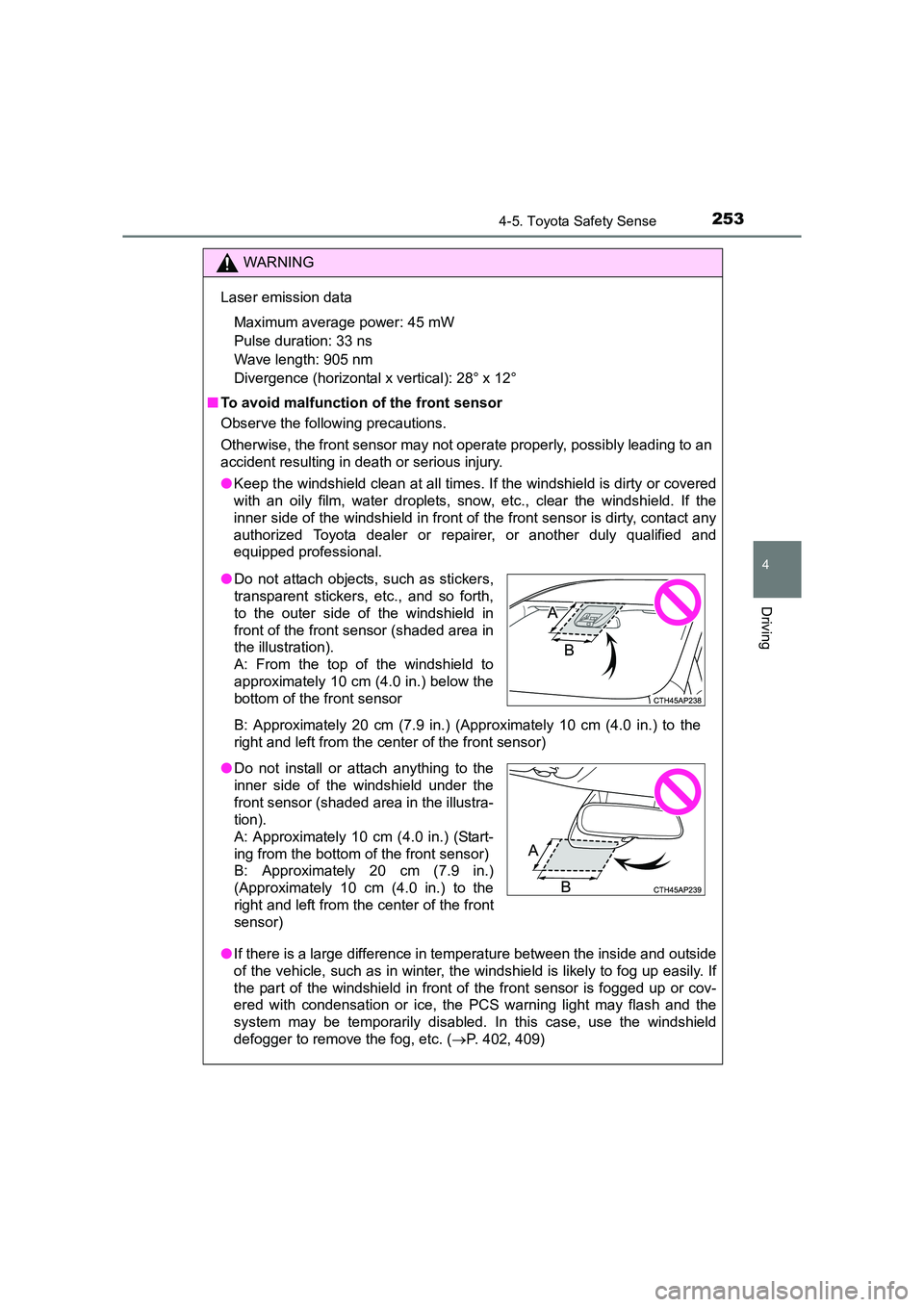
2534-5. Toyota Safety Sense
AURIS Touring Sports_EE (12K53E)
4
Driving
WARNING
Laser emission data Maximum average power: 45 mW
Pulse duration: 33 ns
Wave length: 905 nm
Divergence (horizontal x vertical): 28° x 12°
■ To avoid malfunction of the front sensor
Observe the following precautions.
Otherwise, the front sensor may not operate properly, possibly leading to an
accident resulting in death or serious injury.
● Keep the windshield clean at all times. If the windshield is dirty or covered
with an oily film, water droplets, snow, etc., clear the windshield. If the
inner side of the windshield in front of the front sensor is dirty, contact any
authorized Toyota dealer or repairer, or another duly qualified and
equipped professional.
● If there is a large difference in temperature between the inside and outside
of the vehicle, such as in winter, t he windshield is likely to fog up easily. If
the part of the windshield in front of the front sensor is fogged up or cov-
ered with condensation or ice, the PCS warning light may flash and the
system may be temporarily disabled. In this case, use the windshield
defogger to remove the fog, etc. ( →P. 402, 409)
●Do not attach objects, such as stickers,
transparent stickers, etc., and so forth,
to the outer side of the windshield in
front of the front sensor (shaded area in
the illustration).
A: From the top of the windshield to
approximately 10 cm (4.0 in.) below the
bottom of the front sensor
B: Approximately 20 cm (7.9 in.) (Approximately 10 cm (4.0 in.) to the
right and left from the center of the front sensor)
● Do not install or attach anything to the
inner side of the windshield under the
front sensor (shaded area in the illustra-
tion).
A: Approximately 10 cm (4.0 in.) (Start-
ing from the bottom of the front sensor)
B: Approximately 20 cm (7.9 in.)
(Approximately 10 cm (4.0 in.) to the
right and left from the center of the front
sensor)
Page 289 of 660
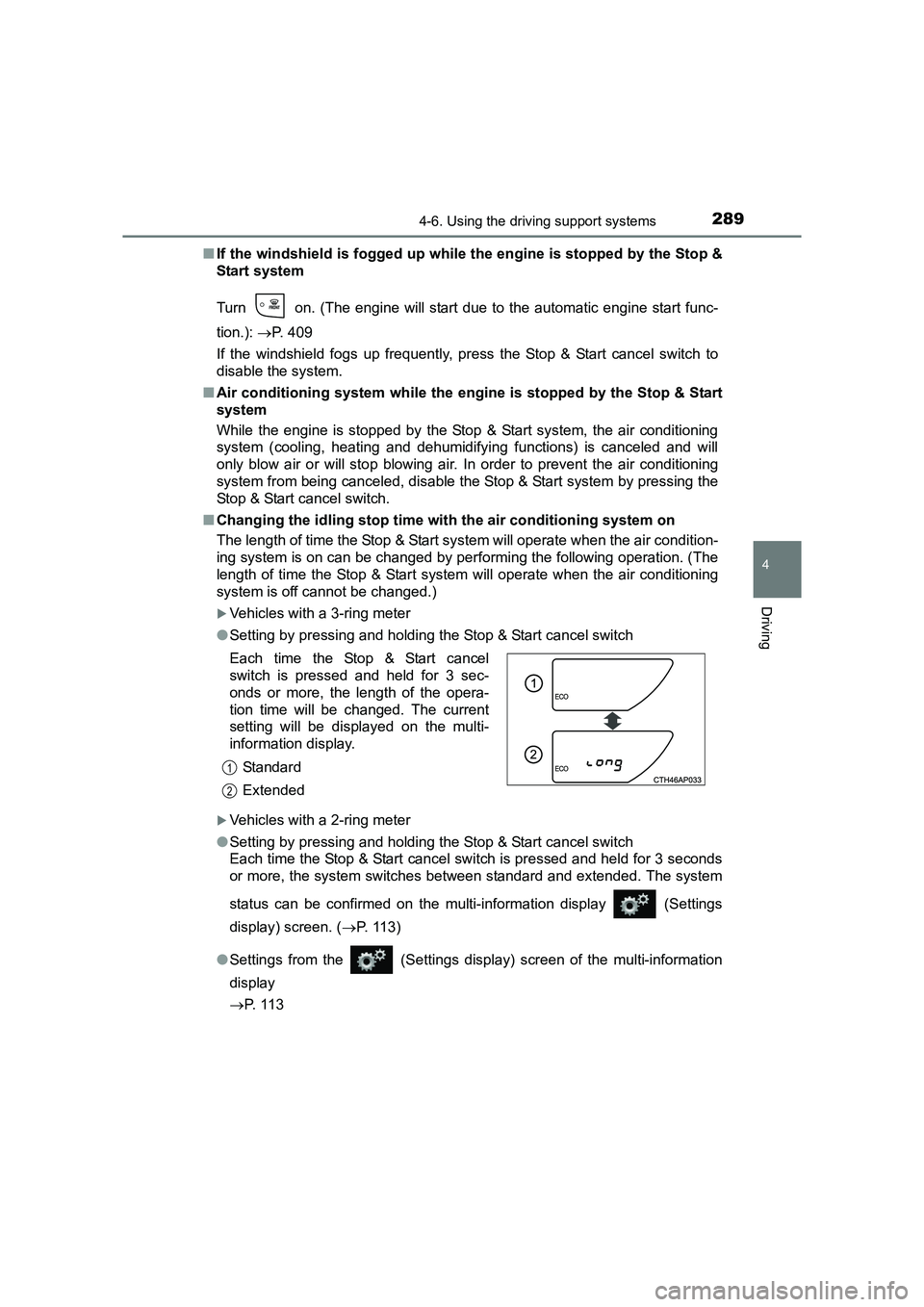
2894-6. Using the driving support systems
AURIS Touring Sports_EE (12K53E)
4
Driving
■If the windshield is fogged up while the engine is stopped by the Stop &
Start system
Turn on. (The engine will start due to the automatic engine start func-
tion.): →P. 409
If the windshield fogs up frequently, press the Stop & Start cancel switch to
disable the system.
■ Air conditioning system while the engine is stopped by the Stop & Start
system
While the engine is stopped by the Stop & Start system, the air conditioning
system (cooling, heating and dehumidifying functions) is canceled and will
only blow air or will stop blowing air. In order to prevent the air conditioning
system from being canceled, disable the Stop & Start system by pressing the
Stop & Start cancel switch.
■ Changing the idling stop time with the air conditioning system on
The length of time the Stop & Start system will operate when the air condition-
ing system is on can be changed by performing the following operation. (The
length of time the Stop & Start system will operate when the air conditioning
system is off cannot be changed.)
�XVehicles with a 3-ring meter
● Setting by pressing and holding the Stop & Start cancel switch
�XVehicles with a 2-ring meter
● Setting by pressing and holding the Stop & Start cancel switch
Each time the Stop & Start cancel switch is pressed and held for 3 seconds
or more, the system switches between standard and extended. The system
status can be confirmed on the multi-information display (Settings
display) screen. ( →P. 113)
● Settings from the (Settings display) screen of the multi-information
display
→ P. 1 1 3
Each time the Stop & Start cancel
switch is pressed and held for 3 sec-
onds or more, the length of the opera-
tion time will be changed. The current
setting will be displayed on the multi-
information display.
Standard
Extended
1
2
Page 313 of 660
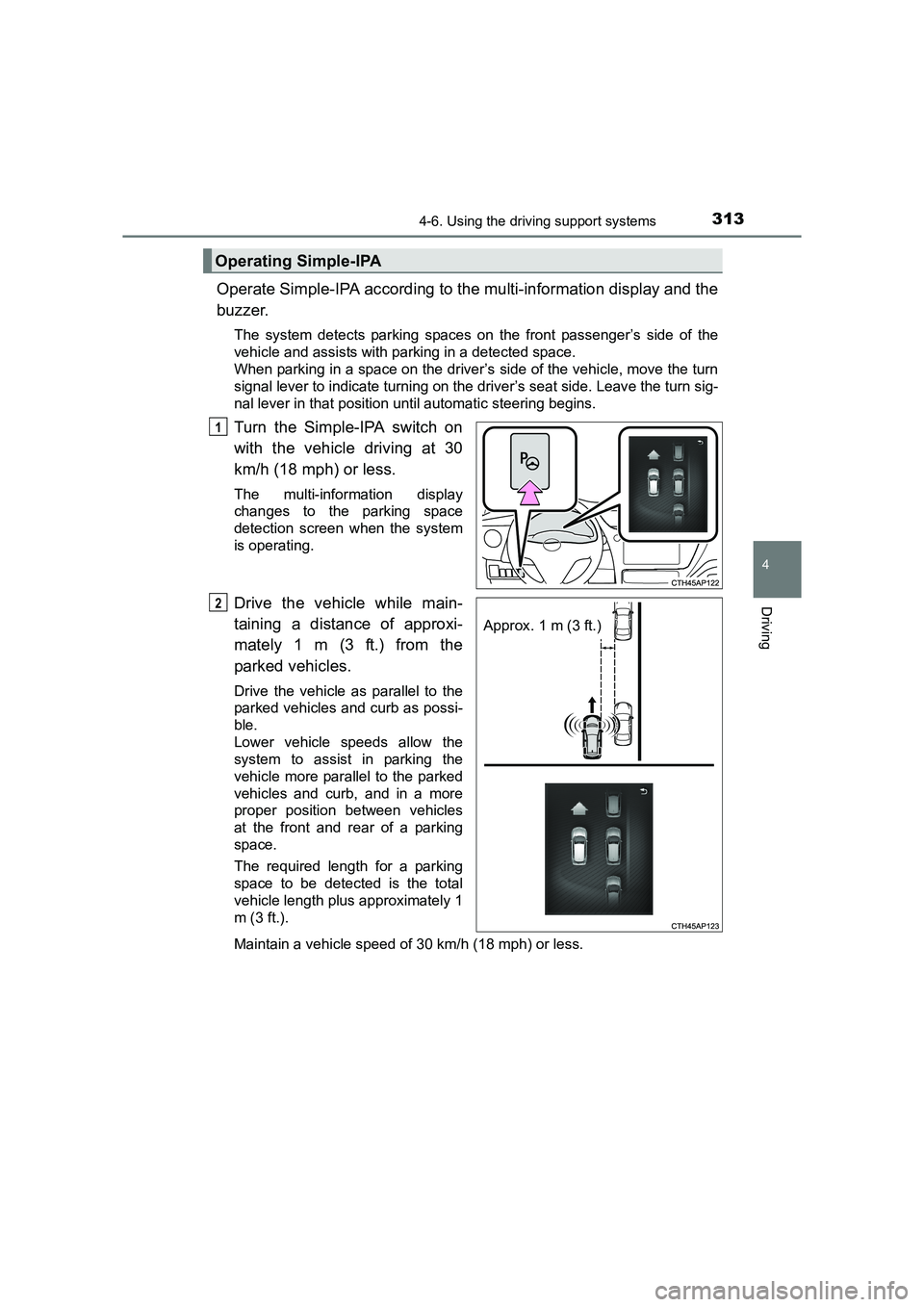
3134-6. Using the driving support systems
AURIS Touring Sports_EE (12K53E)
4
Driving
Operate Simple-IPA according to the multi-information display and the
buzzer.
The system detects parking spaces on the front passenger’s side of the
vehicle and assists with parking in a detected space.
When parking in a space on the driver’s side of the vehicle, move the turn
signal lever to indicate turning on the driver’s seat side. Leave the turn sig-
nal lever in that position until automatic steering begins.
Turn the Simple-IPA switch on
with the vehicle driving at 30
km/h (18 mph) or less.
The multi-information display
changes to the parking space
detection screen when the system
is operating.
Drive the vehicle while main-
taining a distance of approxi-
mately 1 m (3 ft.) from the
parked vehicles.
Drive the vehicle as parallel to the
parked vehicles and curb as possi-
ble.
Lower vehicle speeds allow the
system to assist in parking the
vehicle more parallel to the parked
vehicles and curb, and in a more
proper position between vehicles
at the front and rear of a parking
space.
The required length for a parking
space to be detected is the total
vehicle length plus approximately 1
m (3 ft.).
Maintain a vehicle speed of 30 km/h (18 mph) or less.
Operating Simple-IPA
1
Approx. 1 m (3 ft.)
2
Page 335 of 660
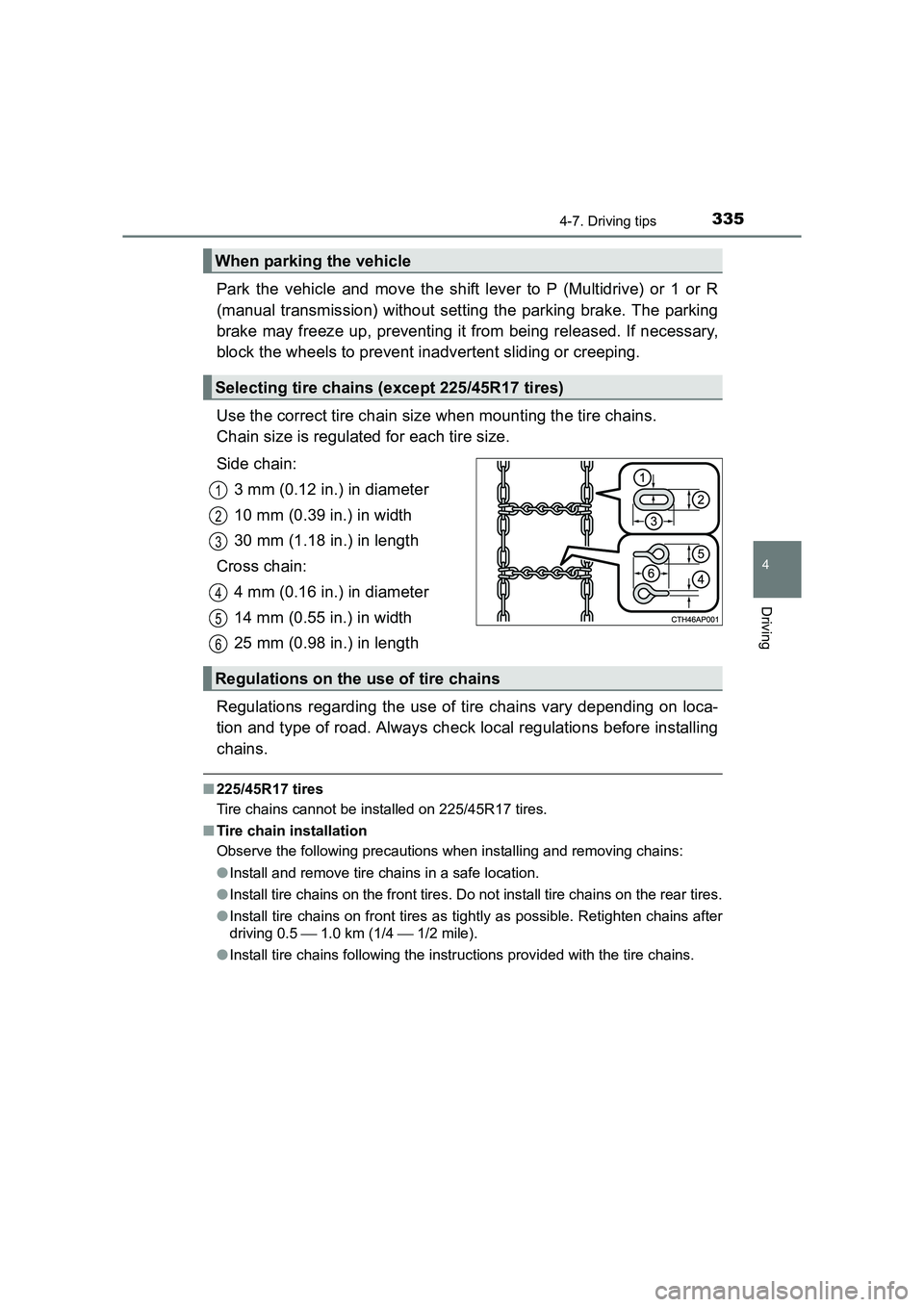
3354-7. Driving tips
AURIS Touring Sports_EE (12K53E)
4
Driving
Park the vehicle and move the shift lever to P (Multidrive) or 1 or R
(manual transmission) without setting the parking brake. The parking
brake may freeze up, preventing it from being released. If necessary,
block the wheels to prevent inadvertent sliding or creeping.
Use the correct tire chain size when mounting the tire chains.
Chain size is regulated for each tire size.
Side chain:3 mm (0.12 in.) in diameter
10 mm (0.39 in.) in width
30 mm (1.18 in.) in length
Cross chain: 4 mm (0.16 in.) in diameter
14 mm (0.55 in.) in width
25 mm (0.98 in.) in length
Regulations regarding the use of tire chains vary depending on loca-
tion and type of road. Always check local regulations before installing
chains.
■ 225/45R17 tires
Tire chains cannot be installed on 225/45R17 tires.
■ Tire chain installation
Observe the following precautions when installing and removing chains:
●Install and remove tire chains in a safe location.
● Install tire chains on the front tires. Do not install tire chains on the rear tires.
● Install tire chains on front tires as tight ly as possible. Retighten chains after
driving 0.5 1.0 km (1/4 1/2 mile).
● Install tire chains following the instru ctions provided with the tire chains.
When parking the vehicle
Selecting tire chains (except 225/45R17 tires)
1
2
3
4
5
Regulations on the use of tire chains
6